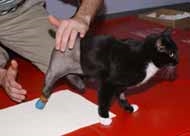New Implanted Prosthetic Limb Surgery Gives Orthopedic Surgeons Options
 |
| George Bailey is shown here after his surgery. Photo provided by North Carolina State University. |
George Bailey, a two-year-old cat born without the lower part of his hind legs, underwent a new surgical procedure March 22, 2005, to implant a prosthetic limb into his left stifle joint. The Osseointegration surgery was described as the first of its kind in the United States by Denis Marcellin-Little, DEDV, DACVS, ECVS. The two-hour surgery represented a collaboration of engineers, veterinarians and students at North Carolina State University that should result in normal limb motion. Although he says the procedure is rare and daring, Marcellin-Little expects Osseointegration to become common within the next five years for animal and human conditions.
“The concept is growing as a way to avoid problems with exterior prosthesis,” said Marcellin-Little, who has worked with limb deformities since 1991. “We are able to do so little for patients missing a quarter of their leg. I always wanted to create something to anchor into the bone.”
Prior to the surgery, which has been likened to a total hip replacement, Bailey’s back leg was mapped with computer software to ensure that the hand-made and polished prosthesis would be the exact length and shape of the original limb, Marcellin-Little said. The hind leg was then built with titanium, tantalum and spring steel, and four screws were used to ensure fixation of the limb, which is made of porous metal, he added.
Bailey is already walking on the modular prosthesis, which is protected by a champagne cork and rubber to increase friction. Doctors will replace the cork with the foot, which Marcellin-Little likened to a ski, once the bone has grown into the prosthesis. He will do a radiograph in four weeks to gauge progress and speaks daily with the cat’s owners, who report that Bailey is very playful, Marcellin-Little said.
In a retail environment the procedure would cost about $40,000, Marcellin-Little said. In this case, the university assumed most of the surgical costs, and the equipment, which carries an estimated million-dollar price tag, was donated.



